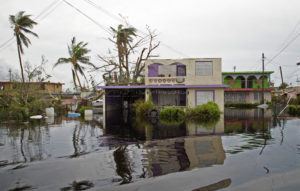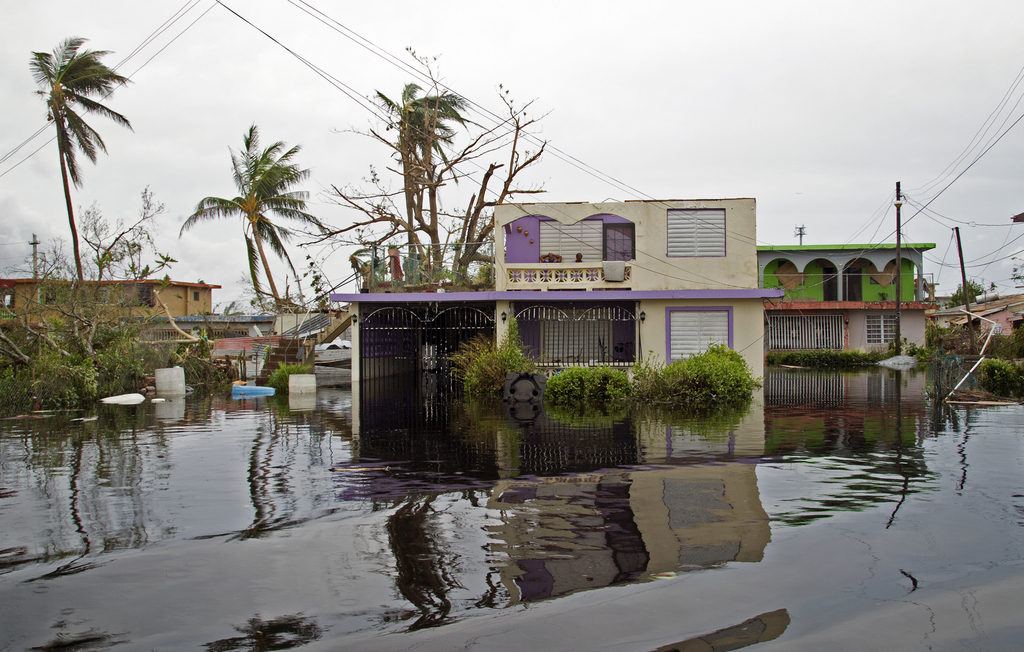Hurricane Maria’s devastation of Puerto Rico may offer a preview for Americans of one of the most jarring potential consequences of global warming: the movement of large numbers of people pushed out of their homes by the effects of climate change.
 Loíza, PR, September 21, 2017 – The community of Miñi Miñi flooded after the Carraizo Dam released water, due to the overflow brought by Hurricane Maria. The category 4 hurricane tore through Puerto Rico on September 20, 2017. Yuisa Rios/FEMA
Loíza, PR, September 21, 2017 – The community of Miñi Miñi flooded after the Carraizo Dam released water, due to the overflow brought by Hurricane Maria. The category 4 hurricane tore through Puerto Rico on September 20, 2017. Yuisa Rios/FEMA
The storm, which destroyed houses, washed away roads and cut off power to the commonwealth’s 3.4 million residents, risks accelerating an exodus that’s already under way as people flee economic stagnation and rising taxes brought on by a fiscal and debt crisis.
On Tuesday, Puerto Rico Governor Ricardo Rossello warned that without “unprecedented relief” from the U.S. government, “thousands if not millions” of residents could leave the island for the mainland. That would strain housing and job markets in the cities that received those people, as well as local government services.
In Puerto Rico, a further drop in population would make it harder to reverse its economic decline. The commonwealth declared bankruptcy in May and has stopped making payments on much of its more than $70 billion in debt. Fewer residents would mean less economic activity, further reducing tax revenue and leaving officials even less able to repay Puerto Rico’s loans.
Scientists say higher water and air temperatures, as well as rising sea levels, increase the intensity and destructive power of hurricanes, a trend that will continue as the concentration of greenhouse gases in the atmosphere increases.
Researchers at the International Monetary Fund, in a report released Wednesday, looked at the links between extreme weather and emigration in more than 100 countries over three decades. They found that “a rise in temperature and greater incidence of weather-related disasters increase out-migration,” according to Petia Topalova, the IMF researcher and lead author of the report.
It describes migration as an “adaptation strategy for households hurt by weather shocks” and predicts that “substantial migration flows, potentially spilling across country borders, could arise if climate change causes a significant rise in sea levels.”
In some parts of the world, that’s already happening. In Africa, climate change forced an estimated 1 million people to leave their homes in 2015; in the Pacific, the World Bank has urged Australia and New Zealand to open their doors to residents forced off small island nations such as Tuvalu and Kiribati. Even in Syria, internal migration sparked by a historic drought contributed to the civil war, which has added to the wave of people trying to enter Europe in recent years.
Maria, which struck Puerto Rico last Wednesday, could expose the U.S. to a similar dynamic. The scale of destruction on the island, combined with its large population and Puerto Ricans’ legal right to move anywhere in the U.S., could prompt migration on a larger scale than other natural disasters.
That raises questions about the country’s ability to handle such a movement of people. The housing market in those cities may not be able to accommodate that kind of influx, according to Jesse Keenan, an expert on climate adaptation at Harvard University.
“Let’s say just 350,000 leave,” Keenan said. Of those, he added, “let’s say just half end up in cities. It’s a major housing crisis. We don’t have that much slack in housing inventory.”
Keenan used the example of New York, which has the largest concentration of Puerto Ricans outside of the island. The city’s traditionally Puerto Rican neighborhoods, where new arrivals might settle — East Harlem, Bushwick, parts of the Bronx — already have low vacancy rates and high rental costs, Keenan said.
“The city of New York right now needs to set up a plan to house these people,” he said. If they’re forced to stay with friends or relatives, “you’re talking about housing being burdened by having too many people legally in the unit,” Keenan said, leading to fire risks, domestic strife and other problems.
Large numbers of newcomers also would place “a tremendous burden on social service delivery, at least for a couple of years,” Keenan said.
Climate Migration
Topalova, the IMF researcher, said that people who leave Puerto Rico because of Maria may have a harder time finding their feet in their new homes.
“Previous IMF work suggests that people who were forced to depart their home country due to various events outside their control may be different, in terms of demographics and skills, than economic migrants,” she said. “They may face greater challenges integrating in the job market relative to economic migrants who – by definition – chose their destination to maximize employment outcomes.”
With enough planning and foresight, the U.S. “will be able to absorb and put to good work a wave of climate refugees,” said Giovanni Peri, an economist at the University of California, Davis, who studies climate migration.
Natasha Lycia Ora Bannan, an associate counsel at LatinoJustice, an advocacy group in New York, got a call Tuesday from a friend on the island, asking if she could help him find a job in the city. She described him as “somebody I never imagined asking that.”
For those who feel they need to leave the island, “this promise of economic opportunity elsewhere often does not lead to a job, or the job that they thought they would encounter,” she said. “I call it the forced migration.”
Was this article valuable?
Here are more articles you may enjoy.


 Oregon Schools Sued for $9M After Young Girl Allegedly Raped
Oregon Schools Sued for $9M After Young Girl Allegedly Raped  Dog-Related Injury Claim Payouts Hit $1.12B in 2023, Report Shows
Dog-Related Injury Claim Payouts Hit $1.12B in 2023, Report Shows  Poll: Consumers OK with AI in P/C Insurance, but Not So Much for Claims and Underwriting
Poll: Consumers OK with AI in P/C Insurance, but Not So Much for Claims and Underwriting  US Eyeing Ship’s Electrical System After Baltimore Bridge Crash
US Eyeing Ship’s Electrical System After Baltimore Bridge Crash 